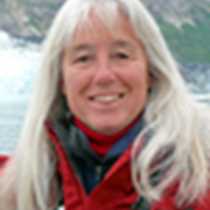Boca de Soledad, Magdalena Bay
Mouth of Solitude is the translation for the location of our whale-watching expeditions today. Our movable “home” for this week, the Sea Bird, remained anchored at the northern tip of Magdalena Island while our dependable fleet of Zodiacs transported guests for closer views of the gray whales that are found here from January through March. The “Boca” is an opening to the Pacific Ocean, which the gray whales have no trouble negotiating despite shifting sandbars and crashing waves. Other than the whales, a population of bottlenose dolphins, some migratory birds, seasonal whale-watchers and the nearby town of Lopez Mateos, the area is indeed remote and isolated. This makes it an ideal place for baby gray whales and their mothers to prepare for their long migration north. Born in the warm, calm waters of Magdalena Bay, the calves have been building their strength and gaining weight rapidly on the rich milk provided by their mothers. We see them side by side, one a miniature version of the other. The babies have already started to accumulate an epi-fauna of their own – the barnacles and “lice” that they carry on their bodies. The latter are crustaceans known as amphipods that feed on bits of whale skin. Also the lifecycle of the crustaceans is geared to the birthing of the whales. Tiny floating larvae become permanently attached adults on the skin of the whales. They feed as the whale swims through the water. Some of these critters are unique to the body of a gray whale and are found nowhere else.
We can’t help but marvel at these magnificent whales and feel a connection with them as our mammal kin. It is exhilarating to be so close to such large yet gentle and accepting animals. We live such different lives in opposing realms but have come together here to share a few special moments that mean so much to us. We are content to believe that in return we have contributed something to the lives of the whales.
Mouth of Solitude is the translation for the location of our whale-watching expeditions today. Our movable “home” for this week, the Sea Bird, remained anchored at the northern tip of Magdalena Island while our dependable fleet of Zodiacs transported guests for closer views of the gray whales that are found here from January through March. The “Boca” is an opening to the Pacific Ocean, which the gray whales have no trouble negotiating despite shifting sandbars and crashing waves. Other than the whales, a population of bottlenose dolphins, some migratory birds, seasonal whale-watchers and the nearby town of Lopez Mateos, the area is indeed remote and isolated. This makes it an ideal place for baby gray whales and their mothers to prepare for their long migration north. Born in the warm, calm waters of Magdalena Bay, the calves have been building their strength and gaining weight rapidly on the rich milk provided by their mothers. We see them side by side, one a miniature version of the other. The babies have already started to accumulate an epi-fauna of their own – the barnacles and “lice” that they carry on their bodies. The latter are crustaceans known as amphipods that feed on bits of whale skin. Also the lifecycle of the crustaceans is geared to the birthing of the whales. Tiny floating larvae become permanently attached adults on the skin of the whales. They feed as the whale swims through the water. Some of these critters are unique to the body of a gray whale and are found nowhere else.
We can’t help but marvel at these magnificent whales and feel a connection with them as our mammal kin. It is exhilarating to be so close to such large yet gentle and accepting animals. We live such different lives in opposing realms but have come together here to share a few special moments that mean so much to us. We are content to believe that in return we have contributed something to the lives of the whales.




